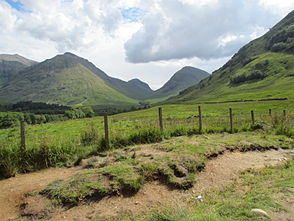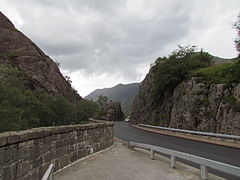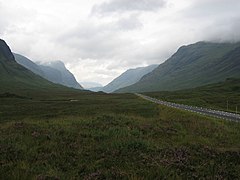Glen Coe
| Glen Coe | ||
|---|---|---|
|
Mountains at the valley entrance |
||
| location | Highland , Scotland | |
| Waters | River Coe , Loch Achtriochtan | |
| Mountains | Glen Coe Mountains | |
| Geographical location | 56 ° 40 ′ N , 5 ° 2 ′ W | |
|
|
||
| Type | Kerbtal | |
| rock | Volcanic rock | |
| height | 87 m ASL | |
| length | approx. 16 km | |
| particularities | Glen Coe massacre | |
Glen Coe ( Gaelic Gleann Comhann ) is a valley ( glen ) in the Scottish Highlands . It is located in the Council Area Highland and was previously part of the traditional County of Argyll . The only village at the end of the valley is Glencoe , the closest sub-center is Ballachulish . The river Coe flows into the bay of Loch Leven , a branch of Loch Linnhe . Glen Coe is a popular hiking and skiing area for tourists. The starting point for visits is often the nearby Fort William , connected to Glen Coe via the A82 .
geology
The Glen Coe is made up of volcanic rock. The current shape of the mountains was largely created by the heavy glaciation of Scotland during the Ice Ages. The valley lies between high, steep mountain ridges and is traversed by the River Coe, into which many small streams flow that come down from the mountains in waterfalls. To the north, the elongated massif of the Aonach Eagach separates Glen Coe from neighboring Loch Leven . The striking cliffs of the Three Sisters of Glen Coe rise up on the south side , they belong to the 1150 meter high Bidean nam Bian massif . The upper entrance of the valley is dominated by the pyramidal north-east face of the Buachaille Etive Mòr . The Buachaille Etive Beag lies somewhat set back between the two massifs . Above the valley entrance lies the wide plateau of Rannoch Moor to the east . The valley entrance from the west shows the distinctive, rounded tip of the Pap of Glencoe .
history
The Scottish writer James Macpherson wrote in his story Ossian, allegedly discovered by him, but in reality falsified, about the fictional character Fingal, whom he equated with the Irish legendary hero and Fianna leader Fionn mac Cumhaill . The writer calls the Glen Coe valley Fingal's home, and this has been preserved in a number of place names, such as the Sgorr nam Fiannaidh (head of Fingal's warriors). The name of the cave above Loch Achtriochtan is reminiscent of the poet Ossian, in Irish mythology Oisín , with Macpherson Fingal's son, after whom the fake novel is named. Fingal is credited with defeating the Vikings under King Erragon of Sora in Macpherson's fiction. Viking influence increased again in the eleventh century when Glen Coe was owned by the powerful MacDougall clan . This clan claimed the valley until 1308 when it was defeated by the future Scottish King Robert the Bruce .
Then it went, including the surrounding mountains, to Angus Og, the leader of the MacDonald clan , who had fought alongside Robert. Angus then left it to his illegitimate son Iain Fraoch, who formed the hapless Clan MacIain Abrach of Glencoe.
Around 1500, the poorer Highland clans such as the MacDonalds began to work as cattle thieves against the richer Lowland clans. There was also a rivalry between the MacDonalds and the Campbells , who had also fought under Robert the Bruce, but had received the Glen Lyon near Perth . Due to their robberies carried out over decades, the Glen Coe clan ultimately became very unpopular with its neighbors.
Far-reaching events began on August 27, 1691 when King Wilhelm III. in London offered a pardon for all Highland clans who fought against him or harassed their neighbors. The condition, however, was that they had to take the oath of allegiance to a judge by January 1, 1692. Those who refused face the death penalty. Clan MacDonald, represented here by the chief of Clan MacIain of Glencoe, reluctantly agreed to take this oath. MacIain erroneously went to Inverlochy near Fort William instead of Inveraray on Loch Fyne . Therefore, he didn't reach Inveraray until January 6th after the deadline. No pardon was granted to his clan, and in 1692 royal soldiers under the command of Captain Robert Campbell of Glenlyon carried out the Glencoe massacre , in which at least 38 valley residents were killed. Since then, the valley in Scotland has also been known as the "Valley of Tears".
After this event, which for many Scots marks the low point in the history of the MacDonald clan, the relationship between the surviving MacIans and the other clans returned to normal.
Others
Several well-known films were filmed at or near Glen Coe, including Highlander - There Can Be Only One , Braveheart , Rob Roy , James Bond 007: Skyfall and Harry Potter and the Prisoner of Azkaban .
Most of Glen Coe is now owned by the National Trust for Scotland . The land was bought by mountaineer and philanthropist Percy Unna, who entrusted it to the trust on condition that the wild nature of the land be protected and preserved. The construction of a visitor center caused some controversy because some saw it as a violation of this requirement. The original center was therefore closed again later and a new one was built at the entrance to the valley. In this visitor center you can get information about the natural conditions, hiking possibilities and the historical significance of the gorge.
The last area of Glen Coe owned by the MacDonalds was the Invercoe area. In 1894 Donald Smith, 1st Baron Strathcona and Mount Royal , bought this area and built the stately Villa Mount Royal. In 2002, Alistair MacDonald of Glencoe acquired the remaining lands from the descendants of Lord Strathcona in a last minute sale. Alistair then, with funds from six donors, set up the Glencoe Heritage Trust , a charitable trust , to preserve the Glen Coe legacy.
The Glencoe Mountain Resort, named after the valley and opened in 1956 as the first ski area in Scotland, is not located in the valley, but a few kilometers east of the valley on the northern slope of the Meall a 'Bhùiridh , south of the Kingshouse Hotel .
- Picture gallery
The A82 in the valley
Web links and sources
- History of Glen Coe ( Memento of April 5, 2012 in the Internet Archive ) on glencoescotland.com (English)
- The bloodbath of Glen Coe ( Memento from May 30, 2009 in the Internet Archive ) on fwf-scot.com
- Glen Coe on the "Discover Glencoe" website
Individual evidence
- ↑ Sgorr nam Fiannaidh on www.munromagic.com , accessed on 26 March 2015
- ↑ a b History of Glen Coe ( Memento of April 5, 2012 in the Internet Archive ) on glencoescotland.com (English)
- ^ Highlander (1986) on scotlandthemovie.com
- ↑ Scotland in movies on alba-schottland.de
- ↑ Fundraising and Support on glencoe-heritage-trust.com
- ^ Gordon Blackstock: It's time to honor the former fighter pilot who started Scotland's skiing revolution. The Sundaypost, November 1, 2016 , accessed January 14, 2019






